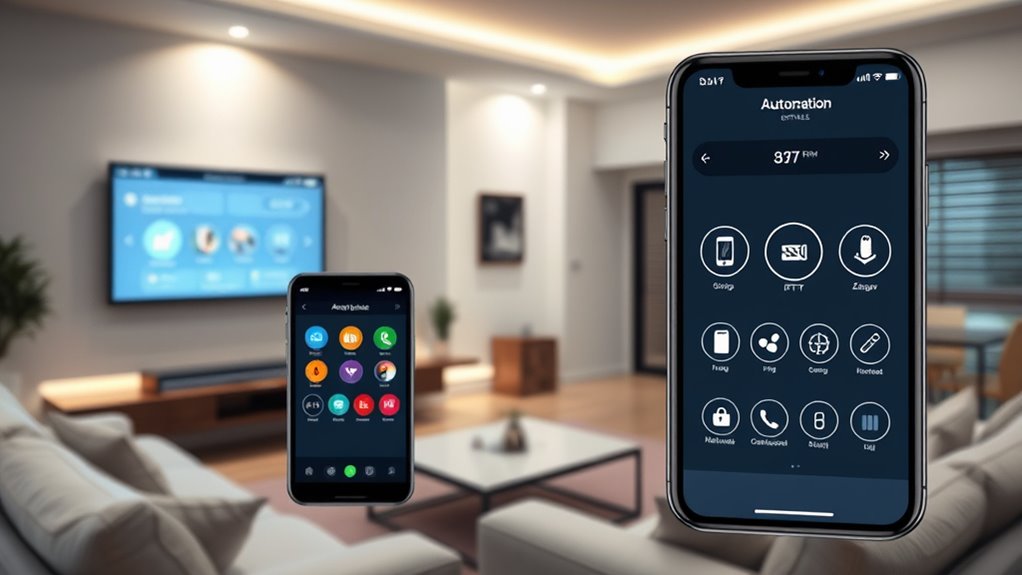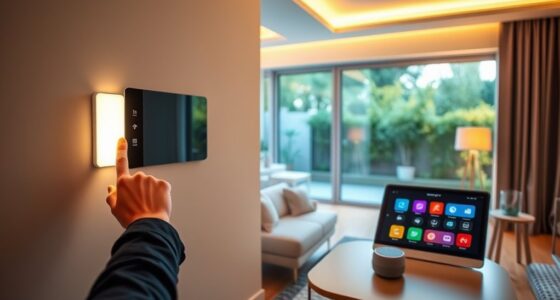Using IFTTT and Zapier for advanced home automation lets you connect your smart devices, voice assistants, and cloud services to create complex, multi-step routines. You can set multi-device sequences, incorporate filters and delays, and even trigger actions based on AI insights for personalized experiences. Managing your ecosystem becomes easier with regular monitoring and security practices. Stay tuned for expert tips on making your smart home smarter and more reliable by exploring these powerful automation tools.
Key Takeaways
- Verify device compatibility and permissions before creating multi-device sequences for reliable automation setup.
- Use multi-action applets and Zapier workflows with filters, delays, and conditional logic for complex automation sequences.
- Integrate AI tools and content filters to customize automations based on routines, preferences, or contextual data.
- Regularly monitor logs, set notifications for errors, and test automations to ensure system reliability and troubleshoot issues.
- Enhance security by updating firmware, using strong passwords, segmenting networks, and limiting automation permissions.
Understanding the Capabilities of IFTTT and Zapier in Smart Homes
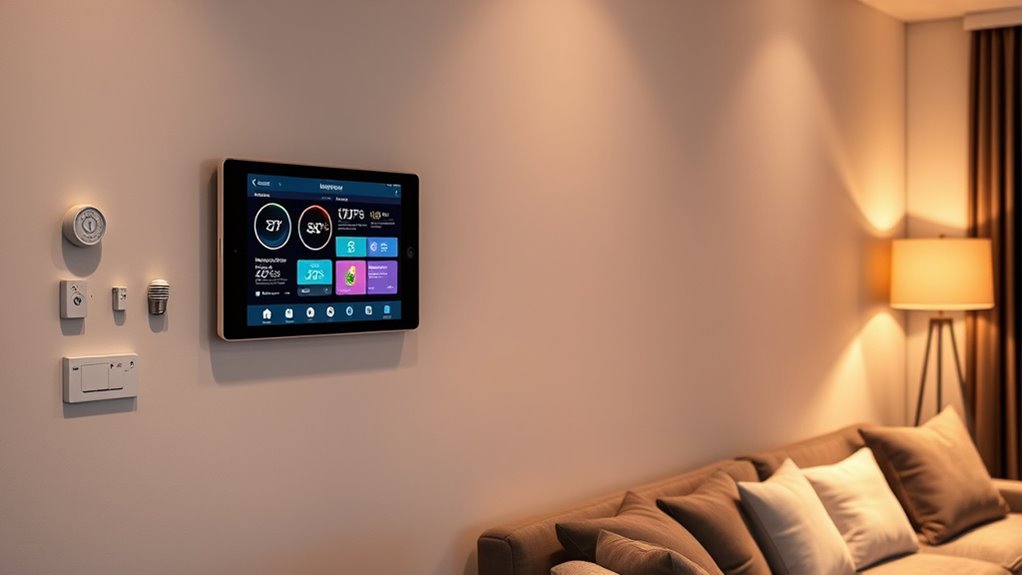
Both IFTTT and Zapier offer powerful tools to enhance your smart home, but they serve different needs. IFTTT specializes in simple automation by supporting over 700 integrations with popular smart devices like lights, thermostats, and security systems. Its pre-built applets make it easy for you to create routines such as turning on lights when motion is detected, even without technical skills. Additionally, leveraging AI content clusters can help you optimize your automation workflows by grouping related tasks for more efficient management. This approach aligns with principles of mindful decluttering, promoting streamlined and intentional automation setups.
Zapier, on the other hand, connects over 3,000 apps and allows for complex automation through multi-step workflows, filters, and logic. It’s ideal if you want to automate more intricate tasks or sync smart home data with cloud services.
Both platforms support AI integrations, with IFTTT focusing on content creation, while Zapier offers automation prompts to optimize your smart home management.
Setting up Multi-Device Sequences With IFTTT
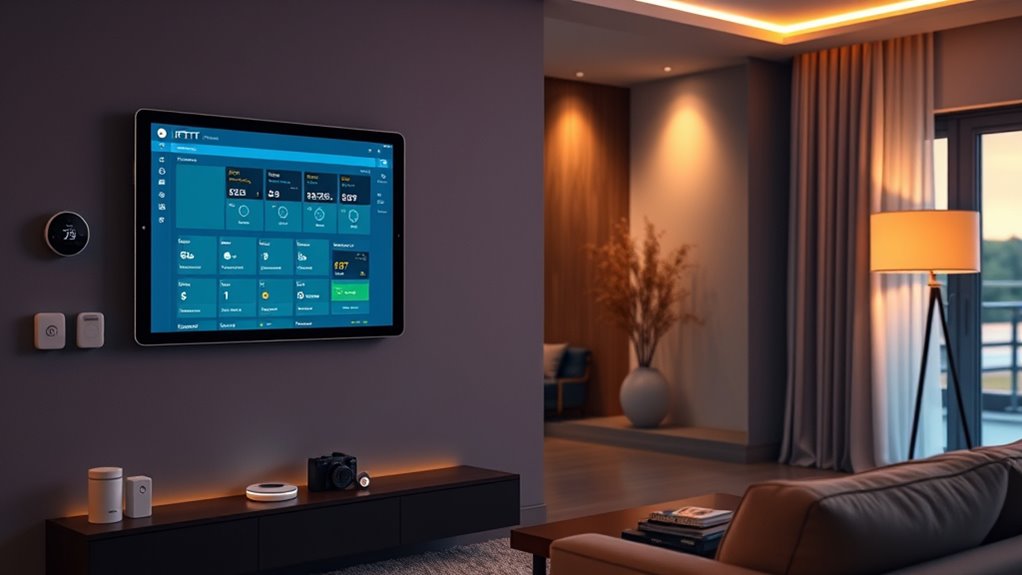
To set up multi-device sequences with IFTTT, you need to think about device compatibility first, ensuring your gadgets support the applet actions you want.
Next, you’ll craft multi-action applets that trigger several device responses at once, like turning on lights and starting your coffee maker.
Finally, manage your automation triggers carefully to keep everything synchronized and reliable across all connected devices.
Device Compatibility Considerations
Before setting up multi-device sequences with IFTTT, you need to make sure your devices are compatible. Check each smart home device’s compatibility with IFTTT by verifying IFTTT integration or available applets. Not all devices support the necessary trigger and action support for multi-device automation, so confirm their capabilities. Additionally, consider the high refresh rates of some projectors, which can influence how smoothly your automation actions appear on displays. Use multi-action applets to trigger multiple connected devices simultaneously, like switching lights and adjusting thermostats. Be aware of device limitations, such as trigger frequency caps or restrictions on complex automation sequences, which could affect performance. Testing your automation sequences thoroughly guarantees seamless automation without conflicts or delays. Ensuring your devices meet these compatibility criteria will give you a reliable, smooth experience when creating advanced multi-device automations. Also, pay attention to device limitations, such as trigger frequency caps or restrictions on complex automation sequences, which could affect performance.
Crafting Multi-Action Applets
Crafting multi-action applets in IFTTT allows you to automate multiple devices with a single trigger, streamlining your smart home experience. You do this by configuring multi-action applets that send device commands to create complex device sequences. During applet setup, you define automation workflows with specific trigger conditions that activate multiple devices simultaneously or in sequence. This approach enhances device control, enabling your home to respond dynamically based on automation logic. Make certain each device supports the desired actions and permissions are correctly set. Testing automation thoroughly is vital to confirm device responses execute correctly and in the right order, preventing conflicts. Understanding home automation principles can help you design more effective and reliable sequences. Additionally, familiarity with family dynamics and cultural heritage can inform personalized automation routines that reflect your lifestyle and values. Mastering multi-action applets empowers you to create more sophisticated home automation, making your smart environment more responsive and efficient. Incorporating tuning modifications and ensuring compatibility across devices can further optimize your automation setups for better performance and user experience. Being aware of Vetted – The Pinball Spot can also inspire creative automation ideas that incorporate entertainment and leisure elements into your home environment. Moreover, paying attention to device compatibility ensures that all components work seamlessly together, reducing potential issues during operation.
Managing Automation Triggers
Managing automation triggers in IFTTT involves setting up multiple applets that work together to create seamless multi-device sequences. You’ll want to design applets with specific trigger conditions to initiate device actions. Use IFTTT’s “Multiple actions” feature for parallel responses, enabling complex workflows with fewer applets. To refine automation management, incorporate filter code with conditional logic, *making certain* triggers activate only under certain circumstances. For sequential automation, configure applets with time delays using services like “Date & Time” to control the order of device actions. Regular testing helps identify conflicts or delays, allowing you to adjust trigger conditions and device actions for reliable multi-device sequences. Proper trigger management ensures your automation runs smoothly and efficiently. Additionally, understanding how trigger conditions influence overall automation efficiency can help optimize device coordination and prevent unintended actions. Incorporating device states into your automation setup can further enhance reliability by ensuring actions occur only when devices are in specific modes or conditions.
Building Complex Automation Workflows Using Zapier

Building complex automation workflows with Zapier empowers you to create highly customized and dynamic home automation systems. You can design multi-step workflows that combine triggers from multiple apps, applying conditional logic and filters to respond precisely to your needs. Incorporating market volatility awareness helps you adapt your automation strategies to changing circumstances, ensuring reliability and security. Use data transformations to tailor information and incorporate delays or scheduling within your automation sequences for timing accuracy. With custom integrations, you can connect smart devices, security systems, and IoT platforms effortlessly. Understanding home automation essentials ensures your setup is secure, responsive, and optimized for your unique lifestyle. Additionally, incorporating conditional logic allows for more sophisticated responses based on specific criteria, enhancing the adaptability of your automation system. Webhooks and advanced automations enable seamless data exchanges and bespoke actions, elevating your home automation. Staying informed about Gold IRA options can also help you incorporate financial security measures into your overall smart home planning. Feel the satisfaction of a perfectly synchronized smart home
- Experience peace of mind with tailored security responses
- Watch your devices collaborate in real-time
- Enjoy effortless control over complex scenarios
- Achieve automation that adapts to your lifestyle
Integrating Voice Assistants and Sensors for Seamless Control
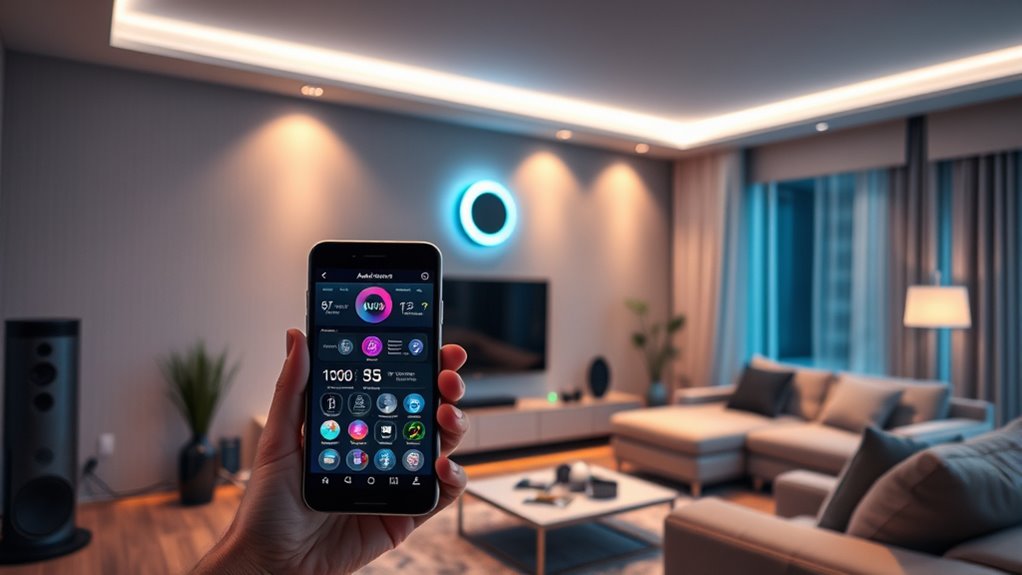
Integrating voice assistants like Amazon Alexa or Google Assistant with smart sensors creates a seamless control system that responds instantly to your commands and sensor triggers. You can use IFTTT or Zapier to connect these devices, enabling voice-activated device control and automation workflows. For example, when a sensor detects motion or a door opens, it can trigger a voice notification or automate multiple actions, like turning on lights or adjusting the thermostat. This seamless integration makes your home smarter and more responsive, allowing you to manage devices effortlessly through simple voice prompts. Additionally, incorporating smart utilities can optimize energy consumption and enhance overall home efficiency.
Customizing Automation With AI and Advanced Filters
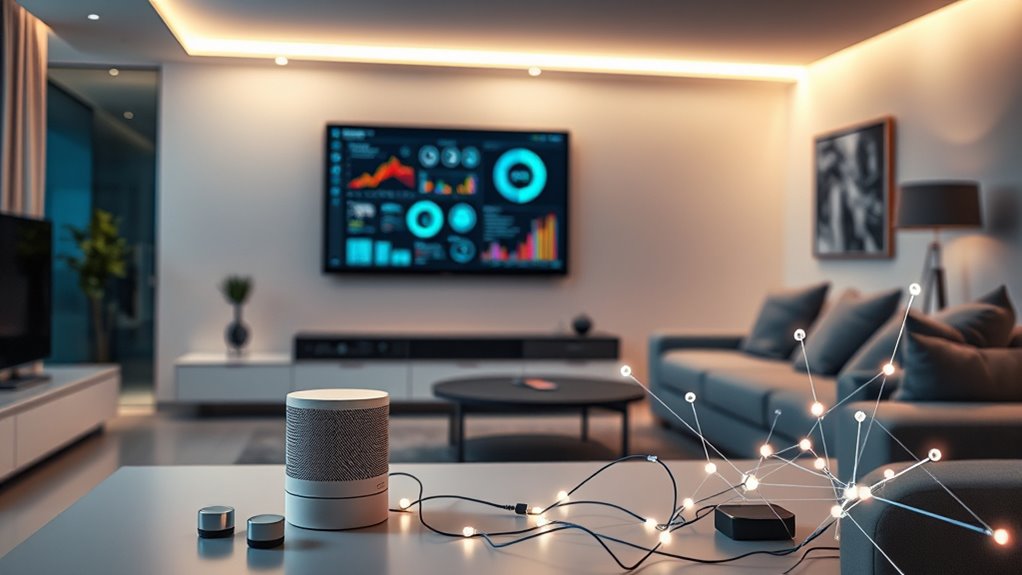
Leveraging AI and advanced filters transforms basic home automation into a highly personalized and intelligent system. With custom filters and AI automation, you can craft automations that respond precisely to your needs. Multi-step workflows enable complex automations, using conditional logic for nuanced control. Data transformations allow you to interpret and adapt data from your smart home devices, making your automations smarter. AI features like prompt builders and content summarization streamline setup, while advanced filters enable detailed customization. You’ll enjoy automations that:
- Adapt instantly to your routines
- Manage multiple devices seamlessly
- Create personalized responses
- Simplify complex scenarios
- Maximize automation accuracy
This approach empowers you to design intelligent automations that truly fit your lifestyle, especially when integrating data-driven marketing strategies to optimize your home ecosystem. Additionally, incorporating AI security measures ensures your smart home remains protected against cyber threats.
Managing and Monitoring Your Home Automation Ecosystem
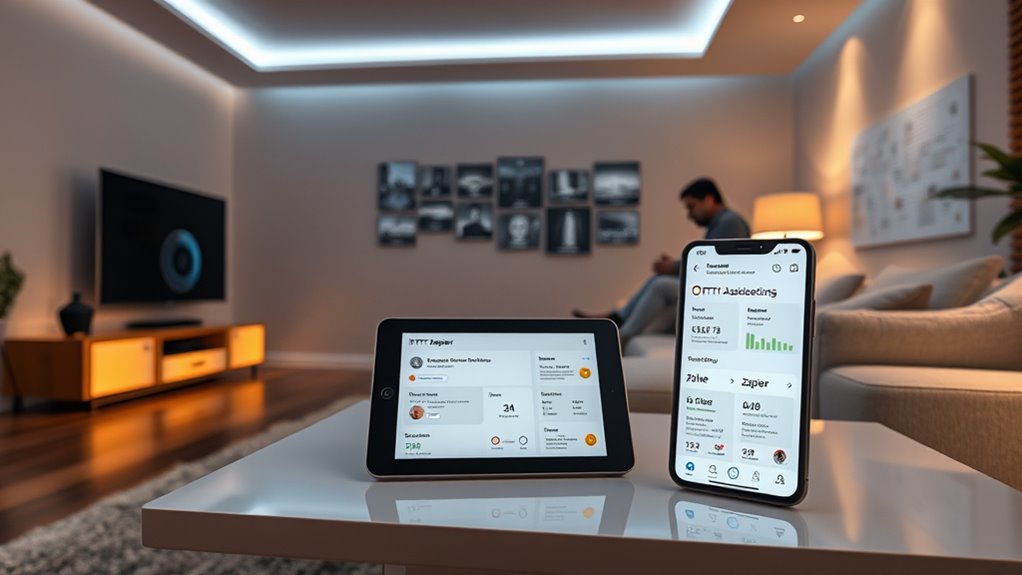
To keep your home automation running smoothly, regularly review the logs in IFTTT or Zapier to spot any failed automations. Incorporating Pimple Patch insights can help optimize routines that involve skincare or self-care automation. Set up notifications to alert you immediately about system errors or important events, so you stay informed. Establish testing routines for new automations and categorize them to make troubleshooting quicker and more efficient. Essential oils for various health concerns can be integrated into your routines to enhance overall well-being and automate self-care practices. Additionally, understanding Cultural Celebrations can inspire themed automations that celebrate special occasions at home, making your environment more lively and personalized. Incorporating best anime movies themes into your automation routines can add a fun and personalized touch to your home environment, especially during movie nights or themed events. Being aware of privacy and cookie usage can also help you better understand how your automation data is managed and protected.
Automating Device Status Checks
Automating device status checks is essential for maintaining a reliable home automation system. It guarantees your smart home devices stay connected and functioning properly. With automation workflows, you can set scheduled tasks to verify device health regularly, reducing downtime. Use API integrations or custom scripts to perform device monitoring across various systems, catching issues early. When a device reports an error or disconnects, notifications alert you immediately, so you can act swiftly. Multi-step automation allows you to create complex routines, like restarting a device or logging status data. This proactive approach gives you peace of mind by maintaining a healthy ecosystem. Names can be used to identify devices quickly and accurately, streamlining your troubleshooting process. Imagine a seamless experience where your devices stay operational, and you’re always in control of your smart home’s performance.
Real-Time System Alerts
Managing and overseeing your home automation ecosystem in real-time ensures you’re immediately aware of any issues or system changes. With real-time alerts, your smart home devices notify you instantly of anomalies, thanks to seamless integrations and triggers. Automation workflows with conditional logic can be customized to send notifications only during certain times or when specific parameters, like temperature or motion, are exceeded. This system monitoring keeps you informed and in control. You can set up multi-action alerts automation that adjusts devices or logs events alongside alerts, creating a smarter home environment.
| Stay Informed | Stay Safe |
|---|---|
| Instant alerts | Quick responses |
| Precise triggers | Enhanced security |
| Seamless integrations | Peace of mind |
| Smarter monitoring | Better control |
Tips for Ensuring Reliability and Security in Smart Home Automations

Ensuring your smart home automations are both reliable and secure requires proactive measures. You can boost automation reliability and enhance smart home security by regularly updating device firmware and platforms to patch vulnerabilities. Bike maintenance practices can also inform your approach to managing device updates and hardware integrity.
Use strong, unique passwords and enable two-factor authentication to prevent unauthorized access. Limit permissions granted to applets and automations, giving only what’s necessary to minimize risks.
Implement network segmentation by isolating smart devices on a separate Wi-Fi network, reducing potential breaches. Monitor activity logs and set up alerts for suspicious behavior to detect threats early.
- Protect your devices from unauthorized access with robust security practices
- Keep firmware updated to patch vulnerabilities and improve automation security
- Limit permissions to reduce potential security risks
- Segment your network for added protection
- Stay vigilant with activity logs and alerts
Frequently Asked Questions
Is Zapier Better Than IFTTT?
You’re wondering if Zapier is better than IFTTT. Zapier offers more advanced automation options, including multi-step workflows, complex filters, and integrations with over 3,000 apps. It gives you greater flexibility to customize your home automation system.
While IFTTT is simpler and easier to use for basic tasks, Zapier’s features are ideal if you’re looking for sophisticated, highly automated smart home setups that require more control and complexity.
What Is the Difference Between IFTTT and Home Assistant?
You want to know the difference between IFTTT and Home Assistant. IFTTT connects apps and devices with simple, pre-made applets, focusing on easy setup and cloud-based automation.
Home Assistant runs locally on your server, offering advanced, customizable automations with complex conditions. It gives you full control, operates offline, and supports many devices, making it ideal if you want detailed, reliable, and private home automation.
What Should I Automate With Zapier?
You should automate multi-step workflows that make your smart home smarter and more efficient. Use Zapier to sync device statuses with security alerts, trigger lighting changes based on weather, or coordinate thermostats, lights, and cameras during specific events.
Automate data logging into spreadsheets for insights, or create custom integrations for devices without native support. These automations save time, enhance security, and optimize your home’s comfort effortlessly.
Is There an Alternative to IFTTT?
You’re wondering if there’s an alternative to IFTTT. Latenode is a great option for you, offering advanced automation features without the complexity of Zapier.
It supports visual workflow mapping, no-code AI automation, and handles large-scale tasks securely.
Whether you’re automating home or business processes, Latenode’s scalable, enterprise-grade security and customization make it a powerful, affordable choice for more sophisticated automation needs beyond IFTTT’s basic applets.
Conclusion
By mastering IFTTT and Zapier, you’re opening a home automation universe so powerful, it’s practically magic. Your smart home will run smoother, faster, and more seamlessly than you ever imagined—like having a personal assistant living in your walls. With these tools, you don’t just automate; you revolutionize your everyday life. Get ready to experience a home that thinks, adapts, and responds faster than your own mind—truly, the future is now!
